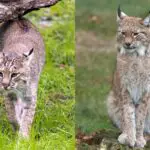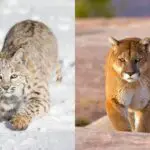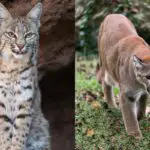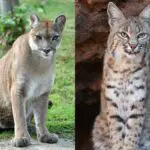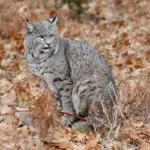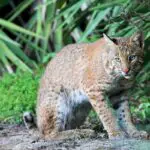Bobcats are an elusive, yet aggressive species of Lynx that live in North and Central America. Skilled hunters, bobcats think nothing of taking down an animal much bigger than themselves.
Another aggressive predator that shares the same semi-arid habitats across the Americas is the coyote.
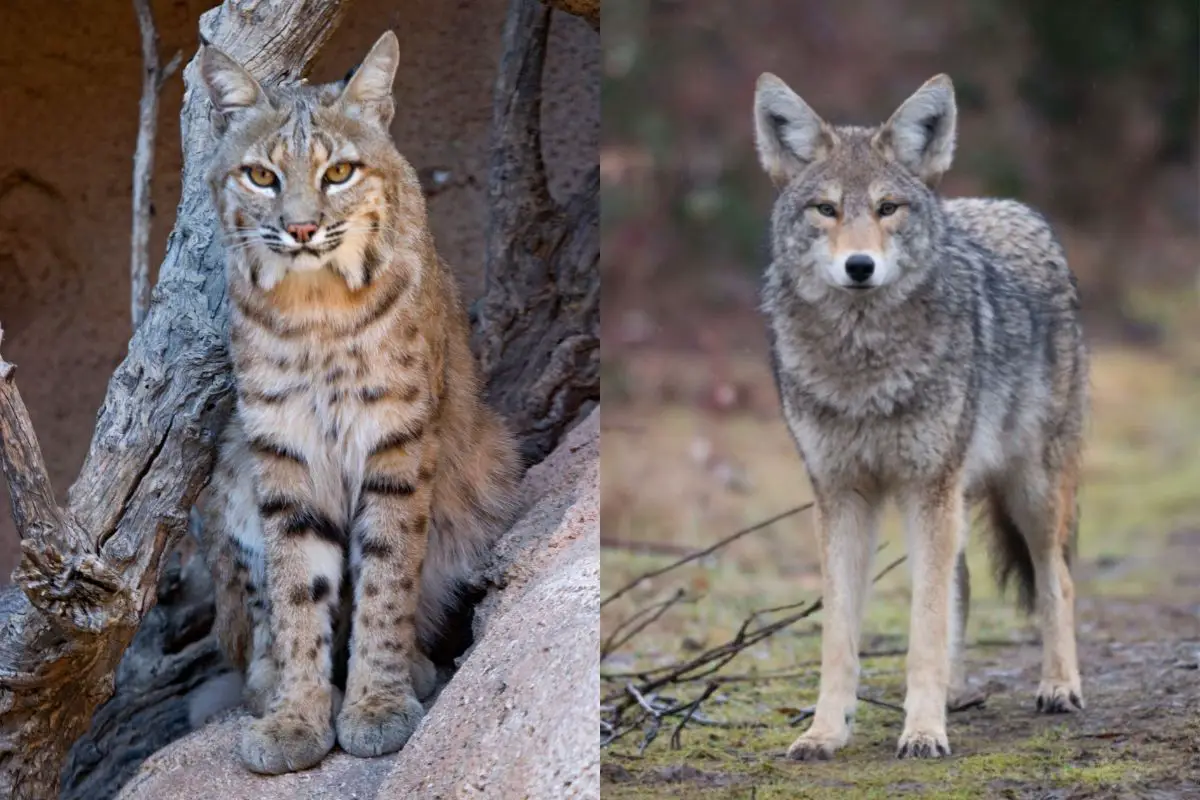
A cousin of the domestic canine, the coyote is about the same size as an average dog. They’re a common sight in the southwest of the United States.
Both predators have a number of things in common, for example, they both use their sharp teeth and claws to drag their prey down. However, in this article, we’re interested in how the two species differ.
In today’s article, you’ll find a comprehensive guide that looks at the main differences between the bobcat and coyote. We’ll look at everything from size and senses to weight and bite power.
We’ll even tell you which species would win in a fight!
Comparing Bobcat Vs Coyote
If you’re in a rush and don’t have time to check out the whole of our article, or simply want a brief explanation first, hopefully, this brief comparison will help!
Both the bobcat and coyote can be found across North and Central America. Although both species are mammals, the bobcat is related to the domestic cat, and the coyote is closely related to domesticated dogs.
Coyotes have a stronger bite than the bobcat and often hunt in packs. Bobcats use their smaller teeth to latch onto the neck of their prey. They will almost always hunt alone.
With a weight that ranges from 15 to 45 lbs, the coyote is also heavier than the bobcat, which only weighs between 11 and 30 lbs.
Despite the two species being similar in size, the coyote is still bigger than the bobcat.
The bobcat grows to reach lengths of 49 inches long and approximately 24 inches high. The coyote reaches lengths of 52 inches and heights of 24 inches.
In terms of appearance, the bobcat has a thick, fluffy sandy-tan-colored coat. On the other hand, the coyote is light gray and red in color. It is almost tawny in color. Both animals have bushy tails.
Size
When it comes to size, the bobcat and coyote aren’t too different. It’s actually quite unusual to have a feline and canine be similar in size.
Both animals aren’t that big. Having said that, the coyote is a bigger species than the bobcat.
At their maximum weight, bobcats only weigh approximately 30 lbs. On the other hand, coyotes can weigh up to 45 lbs.
In terms of length, bobcats only reach lengths of 49 inches, including their tails, and heights of 24 inches.
The coyote can reach a length of 52 inches. Like the bobcat, the coyote will stand at roughly 24 inches high.
Speed And Movement
Both animals are also quite similar when it comes to speed and movement.
The bobcat and the coyote are swift animals that can quickly pounce on their prey when hunting. However, the coyote does have a slight edge over the bobcat.
The coyote can reach top speeds of 40 mph. This is 5 mph faster than the bobcat which can reach a top speed of 35 mph.
In regards to movement, the bobcat can jump up to 12 feet high and hunt from the trees. This is something coyotes can’t do.
However, both animals love to use stealth on the ground when moving through their habitat.

Bite Power And Teeth
Like most mammals, the bobcat has canines, incisors, molars, and premolars. They have distinct, sharp teeth that let the cat latch on to their prey. They will use their super sharp canines to puncture the neck of their prey.
The coyote is similar. They have sharp teeth that easily puncture the neck of their prey. Both species are known for the power of their teeth but which has the stronger bite?
Coyotes win this one too!
Coyotes have a bit power of 648 Newtons. Bobcats have a bite power of 548 Newtons, which is still very strong for their size. Coyotes also have bigger teeth than bobcats.
Both predators easily tear into the flesh of their prey.
Senses
Coyotes and bobcats are both predators and skilled hunters. Their success is all down to their physical attributes and senses.
Their physical attributes help them take down their prey, while their senses help them find it.
Bobcats have excellent vision during the day and at night. They also have a brilliant sense of smell and hearing.
Coyotes are also known to have impressive vision during the day and in low-light settings. Their sense of smell and hearing is also pretty great.
As a result of their impressive senses, we can’t really separate the two species on this front.
Physical Defenses
Physical defenses are where some of the key differences can be seen between the coyote and bobcat.
Although both animals rely heavily on their speed to get away from other predators, the two go about things differently.
The bobcat is incredibly loud. Their loud scream is a threatening call that often scares other animals away. Coyotes tend to use their speed and senses to avoid trouble.
Unlike the bobcat, coyotes also have defense in numbers as they travel in a pack.
Of course, both mammals will also use their claws and teeth to defend themselves if needs must.
Offensive Capabilities
When it comes to attacking their prey, both the coyote and bobcat like to go for the weak spot. This is usually their enemy’s throat. This quickly kills the prey.
Both animals also prefer to attack their prey quickly and instantly. However, there are a few differences.
For starters, bobcats prefer to stalk their prey by sneaking up on them. They will then pounce at the opportune moment.
Coyotes also like to sneak up on their prey, but they aren’t anywhere near as stealthy as the bobcat. Secondly, coyotes prefer to hunt in packs, whereas bobcats hunt alone.
Predatory Behavior
Bobcats and coyotes are ambush predators that use the element of surprise to quickly and almost instantly kill their prey.
The bobcat is more stealthy than the coyote, using its soft feet to walk and run extremely quietly.
Both the bobcat and coyote will use their sharp teeth and claws to fatally bite their prey. More often than not, this is in the neck area.
The main difference between the two when it comes to predatory behavior is that the bobcat is a solitary hunter, while the coyote hunts in packs using persistence predation.
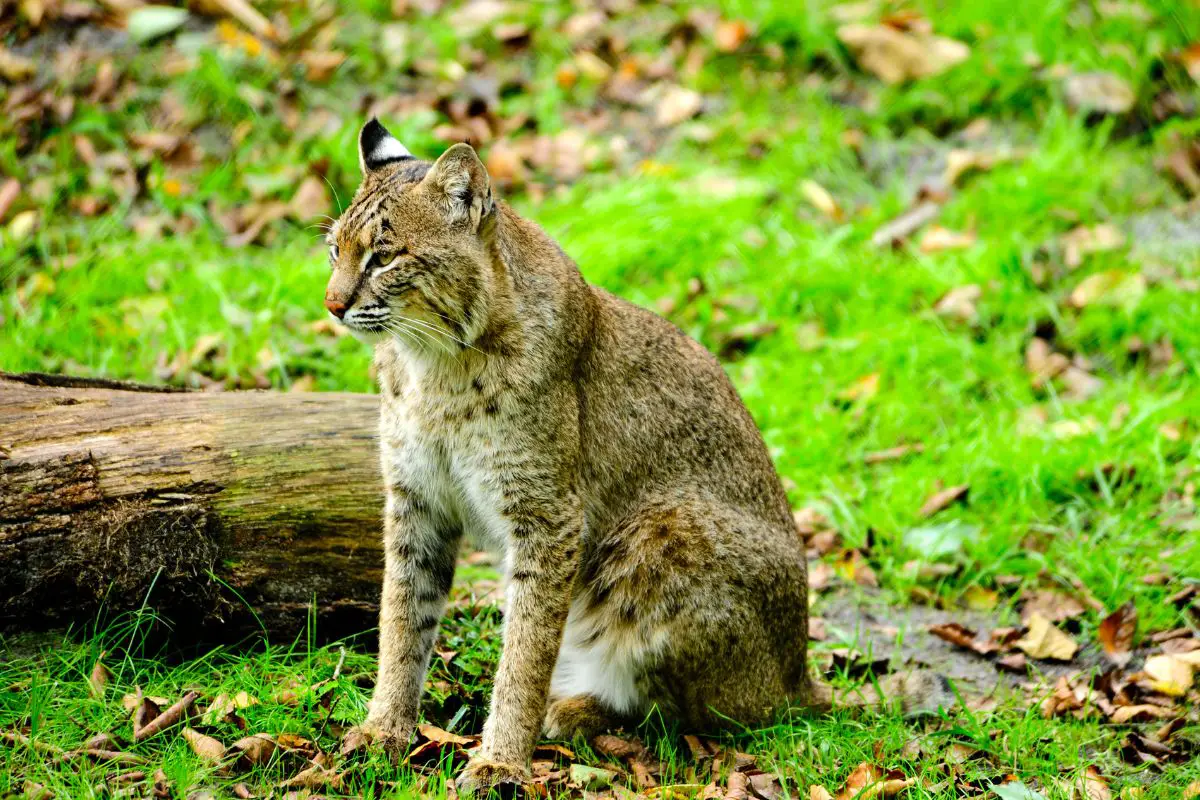
Tracks
Spotting the difference between a coyote and bobcat tracks is actually a lot easier than you may think. The coyote has larger tracks than the bobcat.
The coyote’s paw prints usually show their non-retractable claws too. The shape of the track’s heel pads is another giveaway.
Bobcats have two front lobes and three rear lobes in each heel pad. Coyotes have one front lobe and two rear lobes in their heel pads.
Length
As we’ve already mentioned, the coyote is bigger than the bobcat, although there’s not that much in it.
Both animals stand approximately 24 inches tall. The main difference between the two is their length.
The bobcat can reach lengths of 26 to 41 inches. Another 2 to 7 inches can be added for the length of their tail.
Coyotes are usually anything from 32 to 36 inches in length, with an extra 12 to 16 inches for their tail.
Weight
The two species of animal are also different when it comes to weight. The coyote is normally heavier than the bobcat.
Depending on their size, coyotes can weigh anything between 15 and 45 lbs.
On the other hand, the bobcat usually weighs anything between 11 and 30 lbs. How much each species weighs is dependent on size and gender.
Habitat
Bobcats and coyotes typically inhibit similar habitats. Both can be found across North and Central America in semi-arid areas.
Whether it be in grasslands, forests, mountains, or deserts, there’s a good chance bobcats and coyotes will be found there.
In fact, studies have actually shown that the two species coexist in the same areas. Camera trap footage revealed that the two species commonly pass each other and enter each other’s territory.
Despite sharing a similar setting, they do prefer other things. The bobcat prefers to live in dense deciduous and coniferous forests with plenty of cover. The coyote prefers to live in open areas like deserts.
Geographical Range
As far as geographical range is concerned, the bobcat and coyote aren’t very different. Both can be found all over North America, southern Canada, and northern Mexico.
Both species are also excellent at adapting to different environments whenever necessary. This helps them successfully survive in a wider range of climates.
Body
Bobcats and coyotes can be mistaken for each other, but when you know what each species looks like, distinguishing between the two is pretty easy.
Despite both having pointy ears, the bobcat has tufts of hair at the ends.
The bobcat is also brown or brownish red in color, with a white underbelly. The coyote has pointy ears but no tufts, a grayish brown coat, and a thick, long bushy tail.
The bobcat’s tail is only small and bobbed, hence the name bobcat.
The coyote also has a long pointed nose. This is something the bobcat doesn’t have. Of course, the coyote is also clearly bigger than the bobcat.
Range
Neither the bobcat or coyote have a massive range. Both species prefer to stay in their territory. Both still have a good range, but compared to other animals, their territories are fairly average in size.
Male bobcats usually have a range of approximately 25 sq miles. Female bobcats tend to have a range of roughly 6 sq miles.
Coyotes have a smaller range than bobcats. Coyotes usually have a range of 4 to 15 sq miles depending on size and gender.
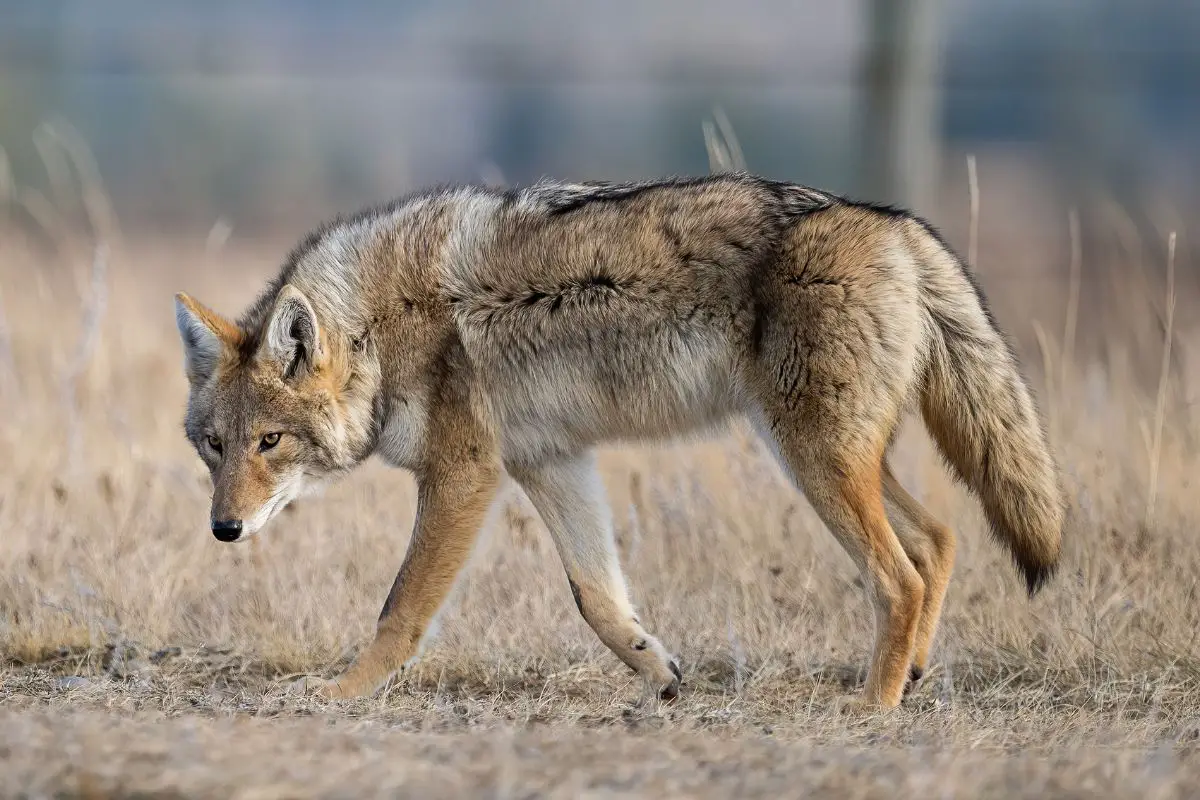
Legs And Feet
Bobcats and coyotes both have long legs. The coyote’s legs are longer, but for its size, the bobcat’s legs are surprisingly big.
While the coyote’s legs let them run quicker than the bobcat, the bobcat’s legs give it enough power to jump 12 feet into the air.
When it comes to the bobcat’s feet, they have paws that reach 1 ½ inches long and 1 ⅜ inch wide.
Coyotes’ paws are almost twice the size of bobcat paws. They usually measure approximately 2 ½ in length, and 2 inches wide.
Fur Color And Patterns
Bobcats are identified by their fluffy, brown, or brownish red fur. The fur on their bellies will usually be white. The tip of their tail will be black. They usually have a spotted coat with grayish markings.
Coyotes have light gray, red, or fulvous fur, interspersed around their body with black and white. Coyotes living at high altitudes tend to be darker in color than those living in deserts.
Tails
The coyote has a much longer tail than the bobcat. Reaching up to 16 inches long, this tail is thick, bushy, and colorful.
The bobcat only has a tail that grows up to 7 inches long. Their tail is short and bobbed. It is the tail that gave the bobcat its name.
Who Would Win In A Fight Between Bobcat And Coyote?
If the bobcat and coyote ever came face to face in a fight, we would have to back the coyote to win.
That doesn’t mean the bobcat couldn’t put up a good fight using its sharp claws and teeth, but the overall bite power, height, size, and weight advantage would probably be enough for the coyote to overcome the bobcat.
If things were based on stealth, the bobcat would have more chance.
Are Bobcats More Aggressive Than Coyotes?
The bobcat is an aggressive species of cat, but it probably isn’t as aggressive as the coyote.
Due to the coyote’s size and power, it is much more fearless than the bobcat, making it more aggressive by nature.
The bobcat might be aggressive, but it would always prefer to run when faced with a threat. A coyote is more likely to fight.
In Summary
On a whole, the bobcat and coyote aren’t that much different. They are both aggressive hunters that share similar settings, kill the same animals, and have similar bodies when it comes to size, height, and weight.
However, there are also lots of key things that set the two species apart.
They both look very different in terms of appearance, the bobcat hunts alone, while the coyote hunts in packs, and the bobcat prefers dense forests, while the coyote prefers open areas.
In this article, we’ve shown you all the main differences between the two species. You should now know exactly what separates bobcats from coyotes.
- Sink Your Teeth Into This: Analyzing the Powerful Lion Bite Force - September 8, 2023
- Siberian Tigers: Everything You Need To Know - September 4, 2023
- Do Lions Eat Humans? Understanding Lion Aggression and Risks - September 4, 2023


